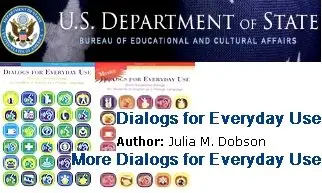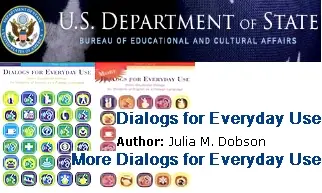Everyday English - Dialogs for Everyday Use and More Dialogs for Everyday Use (Audio)
Publisher: US Department of State, Office of English Lang | 2005 | ISBN: N/A | English | PDF+MP3 | 71 pages | Total Time: ~51 min | 47.22 Mb
Publisher: US Department of State, Office of English Lang | 2005 | ISBN: N/A | English | PDF+MP3 | 71 pages | Total Time: ~51 min | 47.22 Mb
Ideas for Classroom Use.
Dialogs for Everyday Use is a collection of thirty situational dialogs that focus on a wide variety of communicative situations and natural encounters in English. Each dialog is accompanied by a contextual illustration and can be used as a springboard for extended listening and speaking practice. The text also includes language notes that provide useful information on grammar and intonation patterns. This text is suggested for intermediate learners of English.
Dialog 1 - Formal Greetings and Farewells.
Dialog 2 - Informal Greetings and Farewells.
Dialog 3 - Formal Introductions.
Dialog 4 - Informal Introductions.
Dialog 5 - Time.
Dialog 6 - A Telephone Call.
Dialog 7 - Happiness.
Dialog 8 - Ordering a Meal.
Dialog 9 - Birthdays.
Dialog 10 - A Crowded Theater.
Dialog 11 - Mistakes.
Dialog 12 - Games.
Dialog 13 - Health.
Dialog 14 - Sports.
Dialog 15 - Asking Directions.
Dialog 16 - Coincidences.
Dialog 17 - Safety.
Dialog 18 - Musical Instruments.
Dialog 19 - Taking a Vacation.
Dialog 20 - Recipes.
Dialog 21 - Weather.
Dialog 22 - Having Things Done.
Dialog 23 - Mailing Letters.
Dialog 24 - Animals.
Dialog 25 - Shopping.
Dialog 26 - Transportation.
Dialog 27 - Comparing.
Dialog 28 - Pastimes.
Dialog 29 - Weddings.
Dialog 30 - Effort.
Dialog 2 - Informal Greetings and Farewells.
Dialog 3 - Formal Introductions.
Dialog 4 - Informal Introductions.
Dialog 5 - Time.
Dialog 6 - A Telephone Call.
Dialog 7 - Happiness.
Dialog 8 - Ordering a Meal.
Dialog 9 - Birthdays.
Dialog 10 - A Crowded Theater.
Dialog 11 - Mistakes.
Dialog 12 - Games.
Dialog 13 - Health.
Dialog 14 - Sports.
Dialog 15 - Asking Directions.
Dialog 16 - Coincidences.
Dialog 17 - Safety.
Dialog 18 - Musical Instruments.
Dialog 19 - Taking a Vacation.
Dialog 20 - Recipes.
Dialog 21 - Weather.
Dialog 22 - Having Things Done.
Dialog 23 - Mailing Letters.
Dialog 24 - Animals.
Dialog 25 - Shopping.
Dialog 26 - Transportation.
Dialog 27 - Comparing.
Dialog 28 - Pastimes.
Dialog 29 - Weddings.
Dialog 30 - Effort.
More Dialogs for Everyday Use contains thirty-six situation-based dialogs that present spoken American English in a natural way. The text is similar in instructional approach and format to Dialogs for Everyday Use, but includes longer conversational episodes. A photo is included with each dialogue to provide additional contextual support. This book also includes short language notes that focus on specific grammar points. This text is suggested for intermediate to high-intermediate learners of English.
Dialogue 1 - Greetings.
Dialogue 2 - Early In The Morning.
Dialogue 3 - Daily Needs.
Dialogue 4 - Airport Bus.
Dialogue 5 - Making A Date.
Dialogue 6 - Catching A Bus.
Dialogue 7 - Ordering Breakfast.
Dialogue 8 - Near Accident.
Dialogue 9 - Arrival Time.
Dialogue 10 - After The Game.
Dialogue 11 - Going For A Walk.
Dialogue 12 - What's For Dinner?
Dialogue 13 - Academy Awards.
Dialogue 14 - At The Hotel.
Dialogue 15 - After The Movie.
Dialogue 16 - At The Bank.
Dialogue 17 - Discussing A News Story.
Dialogue 18 - Talking It Over.
Dialogue 19 - Weekend Plans.
Dialogue 20 - Dinner Invitation.
Dialogue 21 - Car Insurance.
Dialogue 22 - Parents Night Out.
Dialogue 23 - Discussing The Economy.
Dialogue 24 - Dental Appointment (By Phone).
Dialogue 25 - Making Plans.
Dialogue 26 - Neighborhood Problem.
Dialogue 27 - Car Theft.
Dialogue 28 - Getting Ready.
Dialogue 29 - Making A Purchase.
Dialogue 30 - Mail Time.
Dialogue 31 - Bedtime.
Dialogue 32 - Getting Something Fixed.
Dialogue 33 - Family Plans.
Dialogue 34 - Planning A Business Trip.
Dialogue 35 - A Short Discussion.
Dialogue 36 - Family Squabble.
The Notes concentrate upon words and expressions that are either colloquial or idiomatic in nature. The dialogs themselves are kept short so that if teachers feel that memorization of the dialogs can be a part of the pedagogy of presentation, students will not have to face a seemingly insurmountable task of memorizing long passages. Memorization is encouraged since it often helps to develop both listening and reading comprehension.
Notes: there is no illustration in the text file





